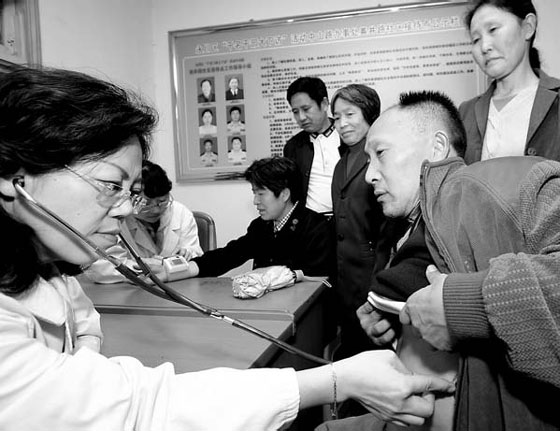
A doctor examines a resident in Chongqing municipality earlier this month as part of a campaign to raise awareness of cancer prevention by providing free medical checkups. Chen Shichuan
Cancer and stroke are the top two causes of death for Chinese, a Ministry of Health (MOH) study revealed yesterday.
The report of the third national study (2006-08) on causes of death also ranked respiratory diseases third on the list and heart diseases, fourth.
The study, which is based on two years of research and covers about 210 million residents of 160 cities and counties, also listed injuries and poisoning as the fifth highest cause of deaths in the country.
Of the two previous MOH reports, the first was launched in the middle of the 1970s and the second, the early 1990s.
"The number of Chinese who died from the above five reasons account for 85 percent of the total deaths," MOH spokesman Deng Haihua told a press conference in Beijing yesterday.
The death rate of the country's rural and urban residents, particularly of those who died from chronic diseases, was also higher than world average levels.
The incidence of stroke in China, for example, was up to five times higher than the record in Europe and the United States, and 3.5 times higher than in Japan.
While China's cancer rate was close to that of the US, Britain and France, it was much higher than other Asian countries like Japan, India and Thailand.
The differences were reflective of the yawning gap between the country's rural and urban areas in terms of health awareness and living standards, Deng said.
Disparities in economic development between rural and urban regions, which lead to an imbalance in medical care and health awareness, can influence the death rate in different areas, he said.
The number of deaths in the countryside was 19 percent higher than in urban areas. Within urban areas, the death rate in less developed western cities was 25 percent higher than in the more developed east.
The five top causes of deaths also ranked differently in urban and rural areas.
Cancer was the No 1 killer in cities, followed by stroke.
In rural areas, stroke cases outnumbered cancer ones, the report showed.
Heart diseases were more common than respiratory diseases in urban areas, while the opposite was true for the countryside.
"The issues of urbanization and an aging society both influence the lifestyle and health habits of citizens," said Rao Keqin, the director of the center for health statistics and information under the MOH.
"With urbanization and economic development, many urbanites have shown unprecedented zeal in pursuing healthy lifestyles," Rao said.
Such residents have been more concerned in recent years about healthy eating habits, the importance of exercise and the quality of living, Rao said.
"Concern for customers' diet and health makes my business different," said a businessman surnamed Zheng, who runs a restaurant serving food cooked with medicinal herbs.
"I believe this is the best advertisement for a restaurant, particularly in big cities," Zheng said.
On the other hand, some eating habits in the rural areas continue to be unhealthy.
For example, people in the rural regions of Hebei province like to eat homemade pickles that have high nitrite content, which can lead to cancer, Rao said.
To promote health awareness, the MOH released a Chinese diet guide in January, which was an update of a decade-old version.
Kong Lingzhi, deputy director of the MOH's disease prevention and control bureau, said it was a timely guide to encourage people to eat healthy to prevent against the worrying trend of chronic diseases.
Currently, the death rate from cancer has increased by 83.1 percent over the mid-1970s and by 22.5 percent over the early 1990s, ministry statistics showed.
In urban areas, deaths from lung, intestine, pancreas and breast cancer are higher, while in rural areas, deaths from liver, stomach, gullet and cervical cancer are higher, Kong said.
Cancers related to living environment and lifestyles -lung, liver, colorectal, breast and bladder cancer - are also said to be rising.
Among these, lung and breast cancer registered the highest increase of 465 percent and 96 percent in the past 30 years, respectively, the MOH report showed.
Lung cancer has also replaced liver cancer to become the top killer among malignant tumors in the country, said Qi Xiaoqiu, the director of the disease control bureau under the MOH.
Referring to the latest report, Qi said the research also included 13 regions reported by media for their high death rates.
"Our statistics show only four of them being above the average death rate in China, seven of them at the same level of the national average rate, and the rest of the two lower than the national average rate," Qi said.
Meanwhile, the country has mastered the screening techniques for eight prevalent cancers, such as lung, liver, stomach, colorectal, esophagus and breast cancer, Qi added.
"The success rate for screening is improving. For example, about 75 percent of esophagus cancer could be detected in the initial stages," Qi said.